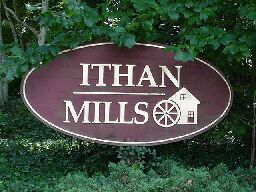Part One: 1682-1977
by Roy Perry - August 2003
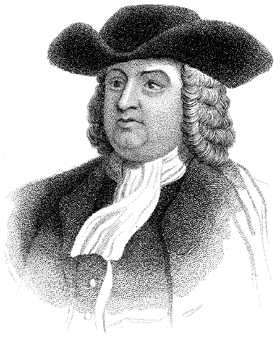
| 12 years after being thrown into prison "for life" in the Tower of London, William Penn spent two productive years in America. Click here for a brief biographical essay. |
Records for the next 70 years are incomplete, even contradictory, but in 1770 it appears that these 39 acres plus the 94 now bordered by Clyde Road, South Ithan Avenue, Sproul Road and "Old" Roberts Road had been combined by the Evans family into one large property. In 1795 David Evans owned and operated a mill along Ithan Creek and had his house and barn there, too, on the land now described as lying between South Ithan Avenue and the Blue Route. What remained of these buildings was demolished during construction of the Blue Route, but some foundations and other artifacts remain on the property. A second house was built in the early 1800's in a field near what is now the site of Ithan Elementary School.
David's sons David and John kept the house, the mills and the acreage along Ithan Creek but in the 1820's sold the other 116 acres to Job Remington, a Philadelphian, for $7,826.43. He sold out to Daniel Abraham 10 years later for $9,351.50, and Abraham put up a house and other buildings. An 1887 map (right) suggests this house is now 111 Drakes Drum Drive. The roadbed of its entryway is now overgrown but can still be seen in the wooded area across from #722 Sproul Road. Abraham stayed till 1893 and then sold to William P. Clyde, perhaps related to B.F. Clyde of Clyde Steamship Company, owner of the estate directly across Sproul Road.
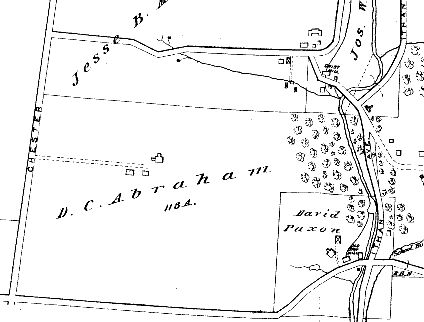
(The B.F. Clyde mansion, now 700 Sproul Road, was subsequently owned by Henry Breyer the ice cream magnate and Slinky inventor Richard James.)
David Evans had moved away after selling the land to Remington, but John stayed and in 1828 started what was to become a world-famous botanical garden on flat land below the Ithan Creek waterfall. By corresponding with other naturalists, John Evans collected plants, especially trees, from all over the world. "Here were assembled pecan trees, cypress, larch, oriental spruce, magnolia and many other unusual specimens sent to the Radnor miller from Kew Gardens in England, the Andes, Himalayas, and all corners of the world. Evans' collection was the most celebrated in America at the time," wrote Albert Curley in the Spring 1955 Bulletin of Radnor Historical Society. As a botanical collector and preservationist Evans was second in fame only to John Bartram, named Royal Botanist by King George III in 1765. Bartram's Garden in Philadelphia is maintained to this day as a valuable historic site, but the Evans collection deteriorated over time. A daughter of John Evans became Radnor's first female School Director in 1875. She married David Paxson (see map above) and lived with him in her father's house but eventually sold both house and land to Dr. James Harrison, who in turn sold to William Ramsey, owner of record as the century ended.
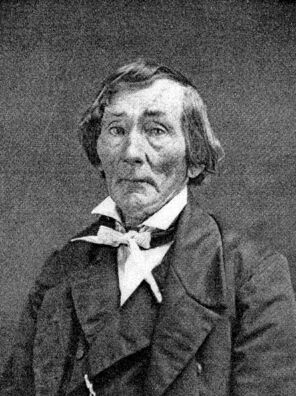
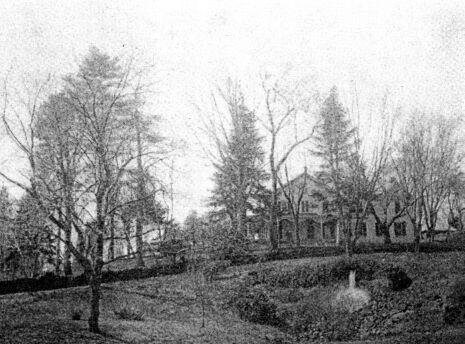
John Evans in an undated photo, and his house in what is now Ithan Valley Park. Sloping stone wall still stands. From "The Botanists Of Philadelphia And Their Work" by John Harshberger pub. 1899 by TC Davis & Sons, Phila.
1870 found most of Radnor (and the Main Line) unchanged from the preceding 200 years, still a sparsely populated area of forests, grain fields, dairy farms and mills. But the next 30 years would witness its abrupt transformation into an ultra-elite residential community of large estates and costly mansions due to the booming manufacturing and shipping economy of Philadelphia and efforts by The Pennsylvania Railroad to develop huge leftover tracts of land it owned following construction of a modern railroad through the area. Suppliers, Board members and directors of the Railroad were strongly urged to purchase this land.
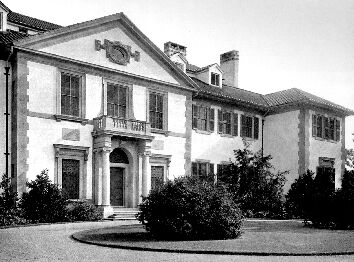
Many did, and built large European-style country homes on their new properties throughout Radnor, Villanova, Rosemont, Ithan, Bryn Mawr and so forth. (Above: Timberline: see next paragraph.)
The turn of the century saw ownership of the land that was to become Ithan Mills pass from William Ramsey to W. Hinckle Smith, who in 1907 built a mansion he named Timberline (pictured above). He died in 1943 and within three years his heirs had lost interest in Timberline. (The house remained unoccupied, deteriorating slowly until its demolition.) Efforts were, however, made by Smith's descendants to preserve John Evans' botanical rarities along Ithan Creek.
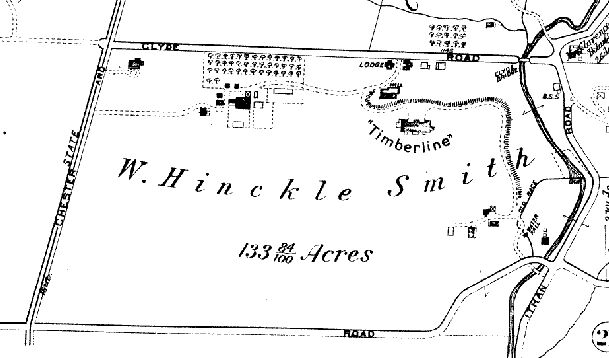
A 1964 count of large or unusual trees in Radnor showed 16 out of 28 such trees were found along the creek in what is now Ithan Valley Park. (map dated 1926)
By then, a changing world, widespread prosperity and the popularization of the automobile had already triggered a second abrupt transformation of Radnor's (and America's) landscape: the explosive growth of suburbs in the years following World War II. Large estates were developed into much smaller properties, each with its own home designed and priced for the average American. The concept of a community smaller than a metropolis yet larger than a farm town was an idea whose time had come. Infrastructure followed: roads, sewers, schools.
In 1960 Radnor Township School District purchased 48.2 acres at the west end of the Smith land to build Ithan Elementary School. The $221,000 price ($4,585 per acre) was negotiated under threat of condemnation. Later that decade Pennsylvania's Department of Highways began the process of acquiring a broad piece of the eastern end of the property to build I-476, The Blue Route. The Bryn Mawr-Broomall portion of The Blue Route was finished in 1970, though the highway did not open for traffic until 1992. Meantime, the long-abandoned Smith family mansion Timberline continued to suffer vandalism and general decay, and is remembered by longtime area residents as a popular gathering place for teenagers.
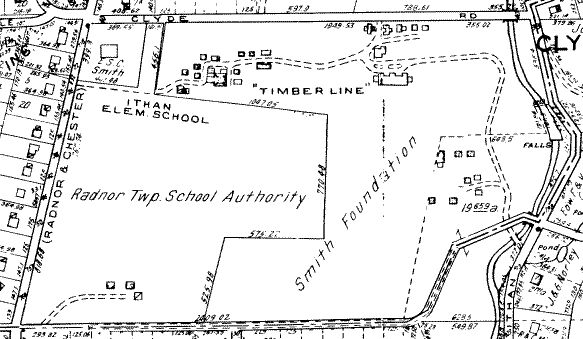
"Highway construction was blocked, but only briefly, when a Smith employee reported traditions of an Indian cemetery in the proposed roadbed. With proper protocol, one misty dawn, the necessary officials gathered near the "graveyard". In the presence of a lawyer for the Smith family, of a Germantown mortician, of representatives of the Highway Department and of the contractor, an accredited archaeologist trenched the land in question but found no remains." (quoted from "A Rare And Pleasing Thing: Radnor Demography and Development" by Katherine Hewitt Cummin, Owlswick Press 1977) (Map above dated 1961)

Land between I-476 and South Ithan Avenue was donated to the Township as a park and property along the west side of Haymarket Lane was donated to the School District as open space. The above is a composite, not an actual map.
"We followed the driveways of the existing estate when we laid out the new streets. We worked with the layout of the land just as the original owners had done," recalls Kazanjian. Balbirnie's assistant at the time, Carol McMichael (now with ReMax Executive Realty), a native of England, named these new streets Haymarket Lane after the hay market in North Umberland where she used to wait for the school bus each day, and Drakes Drum Drive for Sir Francis Drake and his famous drum, which, according to a poem by Sir Henry Newbolt familiar to British schoolchildren, was used to rally his own troops before battle and throw fear into the enemy. Just west of the junction of Haymarket Lane and Clyde Road the original gated entrance to the Smith estate still stands. It had a gate house on either side. One gate house is now #3 Haymarket Lane; the other, which would have been #1 Haymarket Lane, burned to the ground soon after the property was bought, probably due to vandalism.
Streets, curbs and sewer lines were all in place as of May 1, 1976, and construction began. In 1977 the contemporary homes of Ithan Mills went on the market.
In September Anne Castellan, a very early buyer, moved in at 101 Drakes Drum Drive. "One of my memories is the landscaping or should I say lack of it. There were no shrubs around my house and only what I called Builders Rye for a lawn."
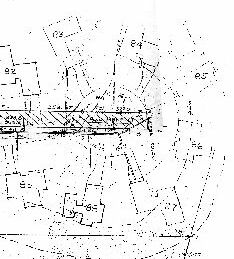
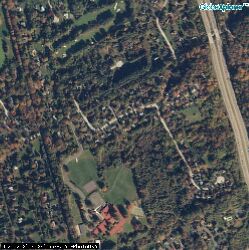
Aerial view: Ithan Mills, Ithan Elementary, Blue Route
click image for enlargement
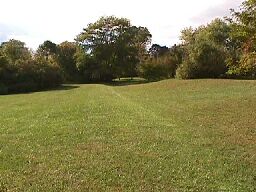
Ithan Mills Common Ground today (see next paragraph)
The Coughenours -- Glenn, Kathy, and infant daughter Corinne -- moved in to 44 Haymarket during the July 4th weekend, 1979, only to find "several neighbors from the rained-out Fourth of July block party huddled in the Gekoski's garage." Glenn recalls, "The common ground was bare dirt, as were most of the lots at this end of Haymarket." He adds that when they weren't busy keeping an eye on all the young kids bustling around, neighbors spent time "nurturing the new trees, shrubs and lawns we had all planted."
